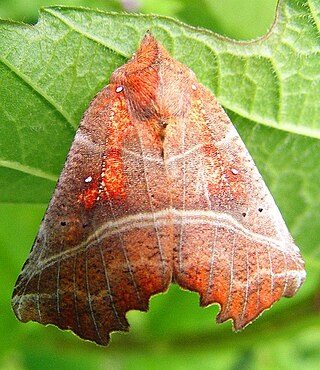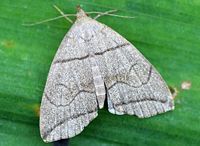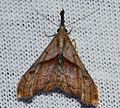
The Arctiinae are a large and diverse subfamily of moths with around 11,000 species found all over the world, including 6,000 neotropical species. This subfamily includes the groups commonly known as tiger moths, which usually have bright colours, footmen, which are usually much drabber, lichen moths, and wasp moths. Many species have "hairy" caterpillars that are popularly known as woolly bears or woolly worms. The scientific name Arctiinae refers to this hairiness. Some species within the Arctiinae have the word "tussock"' in their common names because they have been misidentified as members of the Lymantriinae subfamily based on the characteristics of the larvae.

The Lymantriinae are a subfamily of moths of the family Erebidae. The taxon was erected by George Hampson in 1893.

The Ophiusini are a tribe of moths in the family Erebidae.

The Calpinae are a subfamily of moths in the family Erebidae described by Jean Baptiste Boisduval in 1840. This subfamily includes many species of moths that have a pointed and barbed proboscis adapted to piercing the skins of fruit to feed on juice, and in the case of the several Calyptra species of vampire moths, to piercing the skins of mammals to feed on blood. The subfamily contains some large moths with wingspans longer than 5 cm (2 in).

The Aganainae are a small subfamily of moths in the family Erebidae. The adults and caterpillars of this subfamily are typically large and brightly colored, like the related tiger moths. Many of the caterpillars feed on poisonous host plants and acquire toxic cardenolides that make them unpleasant to predators. Like the closely related litter moths, the adults have long, upturned labial palps, and the caterpillars have fully or mostly developed prolegs on the abdomen. The Aganainae are distributed across the tropics and subtropics of the Old World.

Zanclognatha tarsipennalis, the fan-foot, is a species of litter moth of the family Erebidae. It is found in Europe and east across the Palearctic to Siberia, Amur, Ussuri, Japan, Taiwan, Korea and China.

Herminia is a genus of litter moths of the family Erebidae. The genus was described by Pierre André Latreille in 1802. It was treated as a synonym for Polypogon for some time.

Idia is a genus of litter moths of the family Erebidae first described by Jacob Hübner in 1813.
Mursa is a genus of moths of the family Erebidae.

Renia is a genus of litter moths of the family Erebidae erected by Achille Guenée in 1854.

Chytolita is a monotypic litter moth genus of the family Erebidae erected by Augustus Radcliffe Grote in 1873. Its only species, Chytolita morbidalis, the morbid owlet moth or morbid owlet, was first described by Achille Guenée in 1854. It is found in large parts of North America, from coast to coast in the north and south to North Carolina, Texas and Florida in the west. The habitat consists of deciduous woods and edges.

Zanclognatha is a genus of litter moths of the family Erebidae. The genus was erected by Julius Lederer in 1857.

Asota is a genus of moths in the family Erebidae first described by Jacob Hübner in 1819. Species are widely distributed throughout Africa, India, Sri Lanka, Myanmar, the Malayan region and tropical parts of the Australian region.

Asota speciosa, the specious tiger, formerly Aganais speciosa, is a moth of the subfamily Aganainae, now regarded as part of the family Erebidae. Formerly it was regarded variously as a member of the Arctiidae, the Hypsidae, and subsequently the family Aganaidae, which was formerly regarded as a family by some authorities. The species is widespread in sub-Saharan Africa, such as in Sierra Leone, Togo, Nigeria, Cameroon, Mozambique and South Africa.

The Erebidae are a family of moths in the superfamily Noctuoidea. The family is among the largest families of moths by species count and contains a wide variety of well-known macromoth groups. The family includes the underwings (Catocala); litter moths (Herminiinae); tiger, lichen, footman and wasp moths (Arctiinae); tussock moths (Lymantriinae), including the arctic woolly bear moth ; fruit-piercing moths ; micronoctuoid moths (Micronoctuini); snout moths (Hypeninae); and zales, though many of these common names can also refer to moths outside the Erebidae. Some of the erebid moths are called owlets.

The Erebinae are a subfamily of moths in the family Erebidae erected by William Elford Leach in 1815. Erebine moths are found on all continents except Antarctica, but reach their greatest diversity in the tropics. While the exact number of species belonging to the Erebinae is not known, the subfamily is estimated to include around 10,000 species. Some well-known Erebinae include underwing moths (Catocala) and witch moths (Thermesiini). Many of the species in the subfamily have medium to large wingspans, up to nearly 30 cm in the white witch moth, which has the widest wingspan of all Lepidoptera. Erebine caterpillars feed on a broad range of plants; many species feed on grasses and legumes, and a few are pests of castor bean, sugarcane, rice, as well as pistachios and blackberries.

The Hypenodinae are a subfamily of moths in the family Erebidae. Adult moths of most species of this subfamily lack small, simple eyes near the large, compound eyes and have quadrifine (four-veined) hindwing cells. The micronoctuid moths are an exception because they possess simple eyes and bifine (two-veined) hindwing cells.

Eulepidotinae is a subfamily of moths in the family Erebidae. Adult males in the subfamily have midtibial tufts of hairs. Adult females have the ostial opening located between the seventh and eighth abdominal sternites instead of located anteriorly on the seventh sternite.

The Scoliopteryginae are a subfamily of moths in the family Erebidae. Larvae have distinctive, extra setae on the first through seventh abdominal segments. Many adult moths in the subfamily have a proboscis adapted to pierce fruit skin, allowing consumption of the juice in the fruit.

The Pangraptinae are a subfamily of moths in the family Erebidae.




























